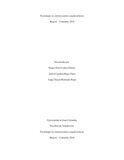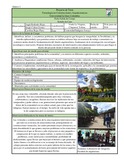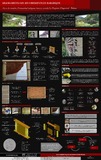Mostrar el registro sencillo del Documento
Mejoramiento del recubrimiento en construcciones de bahareque, por clasificación granulométrica. Caso de estudio, Comunidad indígena Amoyá, vereda La Virginia, Chaparral Tolima
| dc.contributor.advisor | Barreto Castillo, Walter Mauricio | |
| dc.contributor.author | Culma Gómez, Sergio Erick | |
| dc.contributor.author | Rojas Parra, Astrid Carolina | |
| dc.contributor.author | Redondo Rojas, Angie Dayan | |
| dc.date.accessioned | 2019-06-20T14:10:39Z | |
| dc.date.available | 2019-06-20T14:10:39Z | |
| dc.date.issued | 2018 | |
| dc.identifier.uri | http://hdl.handle.net/11396/4383 | |
| dc.description | Las construcciones indígenas, cuentan con una arquitectura única y especial dependiendo del sitio y las costumbres de la comunidad, varían los materiales y las técnicas, por lo que son consideradas patrimonio en diferentes zonas del país. Las viviendas construidas por la comunidad indígena Amoyá (vereda La Virginia, en Chaparral, Tolima) se caracterizan por ser en bahareque tradicional, con estructuras en guadua y madera rolliza local. Actualmente las viviendas de la comunidad realizadas con este método, presentan daños causados en su mayoría por falta de técnica en su construcción, además de los agentes climáticos y bióticos que son muy predominantes en la región. Uno de los mayores problemas es la caída del recubrimiento que trae como consecuencia afecciones en la estructura de la edificación, disminuyendo su resistencia y su vida útil. Con el propósito de mejorar el recubrimiento del bahareque y evitar futuras lesiones en las viviendas a causa de este problema, se realizó el presente estudio, mediante el método investigativo-experimental, de las lesiones y características más importantes de las viviendas construidas en bahareque tradicional por la comunidad, identificadas en la salida de campo, en donde se tomaron algunas muestras de tierra y registro fotográfico de las edificaciones. Se analizó el registro fotográfico, obteniendo los principales problemas constructivos y materiales predominantes en las construcciones. Se realizaron las debidas pruebas en las muestras de tierra traídas de la zona de estudio, se analizaron y concluyeron los resultados, de allí partió la investigación conceptual que permitió desarrollar una respuesta a la hipótesis sobre la cual se desarrollaron los objetivos del presente proyecto. En las pruebas realizadas a la tierra se observó que la baja cantidad de material arcilloso y la abundante presencia de arenas, provocaban que el material de revoque no contará con la suficiente adherencia y por esto con el paso del tiempo se presenten desgastes, fisura y caída del recubrimiento. A partir de estas observaciones se determinó que las propiedades de la tierra mejorarían si pasa por un proceso de separación granulométrica, aumentando el porcentaje de material fino, teoría que se confirmó en la prueba de contracción volumétrica en la cual se utilizó tierra bien tamizada y como resultado se obtuvo una pastilla firme, compacta y muy resistente. Se desarrollaron más pruebas acerca de la extracción granulométrica de las arcillas finas, ya que el propósito era generar una mezcla consistente para el revoque del bahareque que no presentara daños o lesiones como las evidenciadas en la salida de campo. Finalmente se elaboraron dos modelos de prueba que permitieron determinar el comportamiento respecto al proceso tradicional de la comunidad y el propuesto en la presente investigación; se implementó una ficha de seguimiento para consignar los datos resultantes de la construcción de los modelos y de allí se concluyó que, llevando a cabo un proceso de selección granulométrica, teniendo en cuenta el espesor de capas y agregando fibras naturales a la mezcla final para el pañete en estructuras de bahareque, puede aumentar significativamente su funcionalidad y eficiencia. | spa |
| dc.description.abstract | The native constructions have a unique and special architecture depending on the place and customs of the community. The materials and techniques are varied, so they are considered heritage in different areas of the country. The housings built by the Amoyá native community (La Virginia, rural district in Chaparral, Tolima) are characterized by being made of traditional bahareque, with guadua structures and local round wood. Nowadays, the community housings built with this method, present damages caused mostly by lack of technique in their construction, in addition to the climatic and biotic agents that are prevalent in the region. One of the biggest problems is the detachment of the coating that brings as a consequence, harms in the structure of the building, decreasing its endurance and lifetime. In order to improve the coating of the bahareque and avoid future injuries in the housings because of this problem, the present study was made, through the investigative-analytical method, about the most important injuries and characteristics of the housings built in traditional bahareque by the community, identified in the field trip, where some land samples and photographic record of the buildings were taken. The photographic record was analyzed, defining the main constructive problems and predominant materials in the constructions. The appropriate tests with the land samples brought from the study area were carried out, the results were analyzed and concluded, hence the conceptual research that led to the development of a response to the hypothesis on which the objectives of the present project were developed. In the tests made to the land samples, it was observed that the low amount of clayey material and the abundant presence of sands, caused that the plaster material did not have enough adhesion and therefore with the passing of time there are wear, fissure and detachment of the coating. From these observations it was determined that the properties of the soil would improve if it goes through a granulometric separation process, increasing the percentage of fine material, a theory that was confirmed in the volumetric contraction test in which well sieved earth was used and the result was a firm, compact and very resistant plaster. More testings about the granulometric extraction of fine clays were developed, since the purpose was to generate a consistent mixture for the plaster of the bahareque that did not present damages or injuries as those evidenced in the field trip. Finally, two test models were elaborated that allowed us to dictate the behaviors with respect to the traditional process of the community and the one proposed in the present investigation; a monitoring form was implemented to record the resulting data from the construction of the models and it was concluded that by carrying out a granulometric selection process, the final mix for the coat of plaster in bahareque structures can significantly increase its adherence and efficiency. | spa |
| dc.language.iso | spa | |
| dc.subject | Bahareque tradicional | spa |
| dc.subject | Sistema constructivo | spa |
| dc.subject | Granulometría | spa |
| dc.subject | Arcilla | spa |
| dc.title | Mejoramiento del recubrimiento en construcciones de bahareque, por clasificación granulométrica. Caso de estudio, Comunidad indígena Amoyá, vereda La Virginia, Chaparral Tolima | spa |
| dc.subject.lemb | Arquitectura indígena | spa |
| dc.subject.lemb | Arquitectura popular | spa |
| dc.subject.lemb | Patrimonio cultural - Protección | spa |
| dc.subject.lemb | Indígenas - Viviendas | spa |
| dc.subject.lemb | Materiales de construcción - Paja | spa |
| dc.publisher.branch | Bogotá | spa |
Ficheros en el Documento
Este Documento aparece en la(s) siguiente(s) colección(ones)
-
Arquitectura (R) [0]



